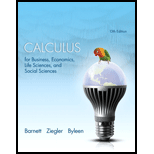
Problems 91–94 refer to the following: If a decrease in demand for one product results in an increase in demand for another product, the two products are said to be competitive, or substitute,
products. (Real whipping cream and imitation whipping cream are examples of competitive, or substitute, products.) If a decrease in demand for one product results in a decrease in demand for another product, the two products are said to be complementary products. (Fishing boats and outboard motors are examples of complementary products.) Partial derivatives can be used to test whether two products are competitive, complementary, or neither. We start with demand functions for two products such that the demand for either depends on the prices for both:
The variables x and y represent the number of units demanded of products A and B, respectively, at a price p for 1 unit of product A and a price q for I unit of product B. Normally, if the price of A increases while the price of B is held constant, then the demand for A will decrease; that is, fp(p, q) < 0. Then, if A and B are competitive products, the demand for B will increase; that is, gr(p, q) > 0. Similarly, if the price of B increases while the price of A is held constant, the demand for B will decrease; that is, gq(p, q) < 0. Then, if A and B are competitive products, the demand for A will increase; that is, fq(p, q) > 0. Reasoning similarly for complementary products, we arrive at the following test:
Test for Competitive and Complementary Products
| Partial Derivatives | Products A and B |
| fq(p, q) > and gp(p, q) > 0 | Competitive (substitute) |
| fq(p, q) < and gp(p, q) < 0 | Complementary |
| fq(p, q) ≥ and gp(p, q) ≤ 0 | Neither |
| fq(p, q) ≤ and gp(p, q) ≥ 0 | Neither |
Use this test in Problems 91-94 to determine whether the indicated products are competitive, complementary, or neither.
92. Product demand. The daily demand equations for the sale of brand A coffee and brand B coffee in a supermarket are
Want to see the full answer?
Check out a sample textbook solution
Chapter 7 Solutions
Calculus for Business, Economics, Life Sciences, and Social Sciences (13th Edition)
- 4. Solve the system of equations and express your solution using vectors. 2x1 +5x2+x3 + 3x4 = 9 -x2+x3 + x4 = 1 -x1-6x2+3x3 + 2x4 = -1arrow_forward3. Simplify the matrix expression A(A-B) - (A+B)B-2(A - B)2 + (A + B) 2arrow_forward[2 pts] 1. Let A = [. 1 -1 0 -343 and B = 05 5 -7 304 Compute (7A - 3B) - 4(2A - B).arrow_forward
- 20 2. Let A = = [ -2 0 1 3 ] and B = 2 3 -1 2 For each of the following, calculate the product or indicate why it is undefined: (a) AB (b) BAarrow_forwardTrue or False and whyarrow_forward10 5 Obtain by multiplying matrices the composite coordinate transformation of two transformations, first x' = (x + y√√2+2)/2 y' = z' (x√√2-2√2)/2 z = (-x+y√√2-2)/2 followed by x" = (x'√√2+z'√√2)/2 y" = (-x'y'√√2+2')/2 z" = (x'y'√√2-2')/2.arrow_forward
- Not use ai pleasearrow_forward4 The plane 2x+3y+ 6z = 6 intersects the coordinate axes at P, Q, and R, forming a triangle. Draw a figure and identify the three points on it. Also find vectors PQ and PR. Write a vector formula for the area of the triangle PQR and find its value.arrow_forward3.1 Limits 1. If lim f(x)=-6 and lim f(x)=5, then lim f(x). Explain your choice. x+3° x+3* x+3 (a) Is 5 (c) Does not exist (b) is 6 (d) is infinitearrow_forward
- 1 pts Let F and G be vector fields such that ▼ × F(0, 0, 0) = (0.76, -9.78, 3.29), G(0, 0, 0) = (−3.99, 6.15, 2.94), and G is irrotational. Then sin(5V (F × G)) at (0, 0, 0) is Question 1 -0.246 0.072 -0.934 0.478 -0.914 -0.855 0.710 0.262 .arrow_forwardAnswer the number questions with the following answers +/- 2 sqrt(2) +/- i sqrt(6) (-3 +/-3 i sqrt(3))/4 +/-1 +/- sqrt(6) +/- 2/3 sqrt(3) 4 -3 +/- 3 i sqrt(3)arrow_forward2. Answer the following questions. (A) [50%] Given the vector field F(x, y, z) = (x²y, e", yz²), verify the differential identity Vx (VF) V(V •F) - V²F (B) [50%] Remark. You are confined to use the differential identities. Let u and v be scalar fields, and F be a vector field given by F = (Vu) x (Vv) (i) Show that F is solenoidal (or incompressible). (ii) Show that G = (uvv – vVu) is a vector potential for F.arrow_forward
 Linear Algebra: A Modern IntroductionAlgebraISBN:9781285463247Author:David PoolePublisher:Cengage Learning
Linear Algebra: A Modern IntroductionAlgebraISBN:9781285463247Author:David PoolePublisher:Cengage Learning

